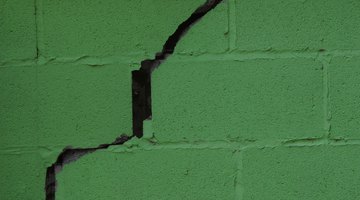What to Use to Fill in a Hole in a Concrete Block in the Basement
Patching different sizes of holes in concrete blocks requires different materials. Patching caulk fills small cracks and holes in concrete blocks easily. Quick-setting concrete patching compound fills medium-sized faults in one application. Larger holes require patches made of ordinary concrete mix and can take a week to reach full strength. Broken concrete needs cleanup, because dirt and crumbling surfaces prevent a patch from bonding. Painting the area with concrete adhesive or thin Portland cement helps patches adhere.

Small Patches
Vertical cracks and holes of no more than 1/2 inch in width, after cleanup, fill easily with concrete repair caulk. Concrete caulk applies with a caulking gun and smooths with a finishing trowel, creating a surface suitable for painting. Actual color when dry might not match the color of the old concrete. This sticky patching caulk keeps its shape while drying in narrow vertical cracks and holes. Chiseling out weak concrete, brushing away debris with a wire brush and flushing the crack clean with water increase the repair's strength. Add beads of caulking compound in layers to fill the flaw.
Medium Holes
Quick-setting cement with acrylic fortifier fills holes up to 1 inch wide, according to Quikrete. Adding the acrylic fortifier to the cement prevents cracking caused by rapid uneven drying. Mixed to the same stiffness as modeling clay, the patch presses firmly into cleaned flaws and cures without sagging. If mixed without acrylic additives, a cement patch must stay damp while curing. Covering the patch with plastic sheeting or misting the patch with water several times a day prevents uneven drying while the patch hardens. VHO patching compound contains polymer bonding agents and fills vertical holes up to 2 inches wide.
Large Holes
Patching a larger hole that penetrates completely through one wall of the concrete block requires a temporary form. Packing the core of the block with clean rubble prevents the new concrete from falling into the empty space. Applying a cement adhesive to the cleaned surfaces of the hole helps the new concrete adhere. To fill a large hole, use stiff ready-mix concrete. After troweling the mixture into the hole, cover and brace the patch temporarily with a piece of plywood. Mist the patch with water regularly while the concrete cures. Even when covered, the old concrete can draw water out of the new patch.
Patching Compounds
Many fast-setting patching compounds require slightly different application methods, so always check the manufacturer's recommendations before choosing a product or starting a concrete repair. Some compounds work well only if applied in layers of about 1/4-inch thickness, with short curing times between applications. Mix only enough for one application to avoid waste. Compounds also vary in texture and stickiness. A thin patching compound fills horizontal flaws efficiently but sags on vertical faults. Stiffer compounds with sticky polymers added can patch even difficult overhead problems. Temperature also matters. Some fast-setting compounds won't cure properly at less than 45 degrees Fahrenheit or greater than 100 degrees Fahrenheit.
References
Resources
Writer Bio
James Young began writing in 1969 as a military journalist combat correspondent in Vietnam. Young's articles have been published in "Tai Chi Magazine," "Seattle Post-Intelligencer," Sonar 4 ezine, "Stars & Stripes" and "Fine Woodworking." He has worked as a foundryman, woodturner, electronics technician, herb farmer and woodcarver. Young graduated from North Seattle Community College with an associate degree in applied science and electronic technology.
Photo Credits
- Hemera Technologies/AbleStock.com/Getty Images
- Hemera Technologies/AbleStock.com/Getty Images
More Articles



